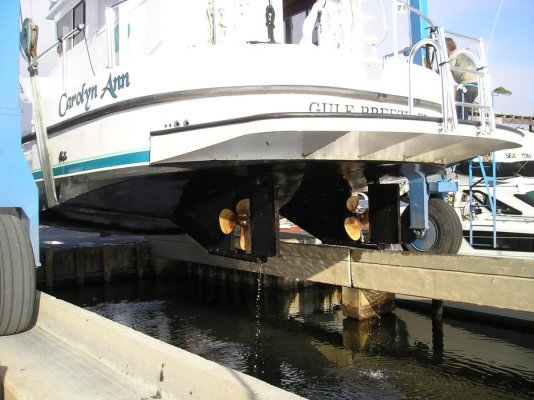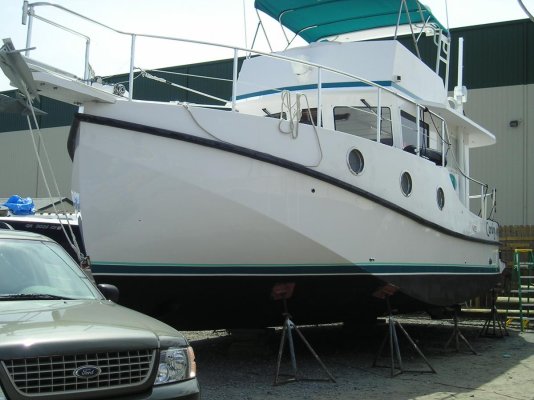Interesting thread, to be sure. I would like to add that there is more than one FD hull type and the differences can have significant effects on performance.
Sea Biscuit (Cecil Boden design; said to be Sharpie-influenced, but designed and built locally) has a flatter aft section for about 1/3 of the boat's 40' length. The deadrise in this hull is perhaps 10° (I will measure this off the plans and get back with this info.) and it varies up to the high bow with its sharp entry. She weighs 15 tons, but only draws 4'.
On our maiden voyage back from Qld, as I wrote elsewhere here, we covered 550nm in 62 hours, and used ~650 litres of fuel. We rode the East Australia current most of the way, and it was running at 2–3kn South, around 35nm offshore, on average.
This boat behaves as Willy described above (talking about SD hulls): in confused sea states, the roll accelerations are fast—completely different to the fishing boats I have been on. Overall, a much smaller roll amplitude, but much faster. As well, as she was originally designed as a cray boat, with a fish well a little ahead of amidships, she is relatively tail heavy (fuel tanks in rear compartment; engine in the next) so her pitching rotation point is closer to the 2/3rds mark, not amidships. This means that the forward cabin is moving too much to be rested in—my co-skipper and I used the wheelhouse bunk for our off-watch rests as a result. I plan to move the house battery bank forwards to help this, and perhaps add another water tank too, also forwards; there's plenty of room.
At rest, anchor or dock, she does not roll like a round-bottom FD hull, either, and she is resistant to being waked. I have not taken her offshore in anything more than 2m swells, but the rolling is way less than the fishing boats of similar size I mentioned above. At the dock, the hull is quiet, in terms of wave slap.
A note on fuel consumption WRT FD hulls; on flat water, Sea Biscuit (120hp Perkins, 28" prop) can be pushed to 8.2kn or so—but then her wake is significant and she is sitting in a trough. At the "one Kn below hull speed" that Willy recommended above (which corresponds reasonably closely to Captain Beebe's 1.1 S/L ratio, so about 7kn) SB makes zero wake, and this corresponds to about 1,250rpm on the Perkins. We ran her at this rpm for most of the trip, raising this to 1,450 for the last leg south of Sydney, where we had less EAC assist.
So, although SB is a FD hull, in many ways this design is more similar to the SD hulls I have been on (but without the sprinting speed!).


